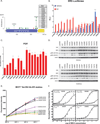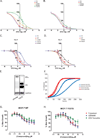Activating ESR1 Mutations Differentially Affect the Efficacy of ER Antagonists
- PMID: 27986707
- PMCID: PMC5340622
- DOI: 10.1158/2159-8290.CD-15-1523
Activating ESR1 Mutations Differentially Affect the Efficacy of ER Antagonists
Abstract
Recent studies have identified somatic ESR1 mutations in patients with metastatic breast cancer and found some of them to promote estrogen-independent activation of the receptor. The degree to which all recurrent mutants can drive estrogen-independent activities and reduced sensitivity to ER antagonists like fulvestrant is not established. In this report, we characterize the spectrum of ESR1 mutations from more than 900 patients. ESR1 mutations were detected in 10%, with D538G being the most frequent (36%), followed by Y537S (14%). Several novel, activating mutations were also detected (e.g., L469V, V422del, and Y537D). Although many mutations lead to constitutive activity and reduced sensitivity to ER antagonists, only select mutants such as Y537S caused a magnitude of change associated with fulvestrant resistance in vivo Correspondingly, tumors driven by Y537S, but not D5358G, E380Q, or S463P, were less effectively inhibited by fulvestrant than more potent and bioavailable antagonists, including AZD9496. These data point to a need for antagonists with optimal pharmacokinetic properties to realize clinical efficacy against certain ESR1 mutants.Significance: A diversity of activating ESR1 mutations exist, only some of which confer resistance to existing ER antagonists that might be overcome by next-generation inhibitors such as AZD9496. Cancer Discov; 7(3); 277-87. ©2016 AACR.This article is highlighted in the In This Issue feature, p. 235.
©2016 American Association for Cancer Research.
Figures



References
-
- Early Breast Cancer Trialists' Collaborative G. Effects of chemotherapy and hormonal therapy for early breast cancer on recurrence and 15-year survival: an overview of the randomised trials. Lancet. 2005;365(9472):1687–1717. PubMed PMID: 15894097. - PubMed
-
- Mouridsen H, Gershanovich M, Sun Y, Perez-Carrion R, Boni C, Monnier A, et al. Phase III study of letrozole versus tamoxifen as first-line therapy of advanced breast cancer in postmenopausal women: analysis of survival and update of efficacy from the International Letrozole Breast Cancer Group. Journal of clinical oncology : official journal of the American Society of Clinical Oncology. 2003;21(11):2101–2109. PubMed PMID: 12775735. - PubMed
-
- Merenbakh-Lamin K, Ben-Baruch N, Yeheskel A, Dvir A, Soussan-Gutman L, Jeselsohn R, et al. D538G mutation in estrogen receptor-alpha: A novel mechanism for acquired endocrine resistance in breast cancer. Cancer research. 2013;73(23):6856–6864. PubMed PMID: 24217577. - PubMed
MeSH terms
Substances
Grants and funding
LinkOut - more resources
Full Text Sources
Other Literature Sources
Medical
Miscellaneous

